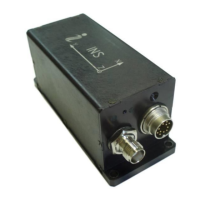INS
GUI User’s Manual
Inertial Labs, Inc
TM
Address: 39959 Catoctin Ridge Street, Paeonian Springs, VA 20129 U.S.A.
Tel: +1 (703) 880-4222, Fax: +1 (703) 935-8377 Website: www.inertiallabs.com
134
10.7.2. INS operation with encoder-based odometer
(wheel speed sensor)
Note: for operation with encoder-based odometer the INS unit should have factory
configured port to receive pulse/bi-phase signals from encoder. Please contact Inertial
Labs for information about this.
Go to “Devices options…” window, “External sensors” tab and check
“Encoder-based odometer” checkbox (see Fig. 10.24).
Then check/set the next parameters:
– Pulse length – is the distance in meters between low to high transitions
of the encoder signal;
– Odometer offset – is the lever arm measured from the accelerometer
mass-center of the INS unit (see Fig. F.1 in Appendix F) to the point at
which the vehicle's tire makes contact with the road in the vehicle co-
ordinate frame, in the right, forward and vertical directions.
– STD_Vh (m/s) – is standard deviation of the odometer noise. Usually its
value is 0.10 m/s, but it depends on encoder.
– k_Sigma_V – is residual threshold. Its default value is 10.
Please contact Inertial Labs to get recommendations for odometer
parameters value.
The pulse length can be calculated using formula:
Pulse length = pi*D/n;
where D – is wheel diameter (in meters); n – is number of pulses per
revolution.
The pulse length should be set accurately because INS position calculation
at GNSS outage is highly depends on pulse length accuracy. On the other
hand, the pulse length can be set approximately or even set to zero if the
odometer calibration procedure will be performed before ordinary operation
of INS with odometer (see section 10.7.3).

